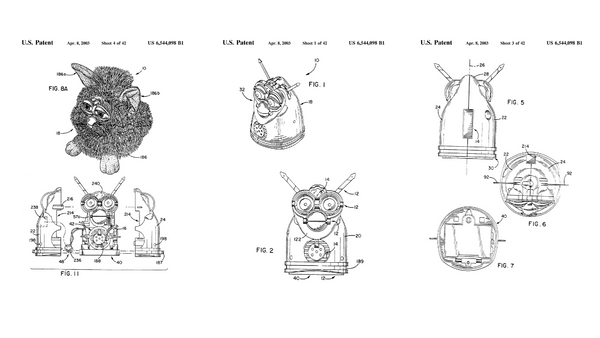Multiple news outlets reported on the supposed ban, citing an internal NSA memo. Snopes reached out to the agency, as well as the U.S. Department of Defense and Hasbro (the toy's manufacturer), seeking a copy of that document for independent verification. We will update this report when, or if, we receive responses.
When it first hit toy stores in 1998, Furby was an immediate sensation. The animatronic furball would eventually be recognized by Time Magazine as one of “History’s Best Toys.” And just as it spiked in popularity among children looking for a new robotic friend, security officials were reportedly concerned over the robot’s potential to record top-secret information.
Since 1999, claims online have circulated about the U.S. National Security Agency (NSA) supposedly banning Furbys from its premises over fears the toy could be used as a spying tool. Media outlets across the world — including the BBC, The Guardian, CNN, CBS News, and The Independent, among others — reported on the supposed ban.
All such stories stemmed from reporting by The Washington Post. On Jan. 13, 1999, The Post published an article titled “A Toy Story of Hairy Espionage” that read, in part:
As harried parents scrambled in the weeks before Christmas to get their hands on these homely, high-tech cyberpets that supposedly repeat what they hear, the supersecret spy agency put out a "Furby Alert" on its internal intranet in early December and banned the Furby from Fort Meade. "Personally owned photographic, video and audio recording equipment are prohibited items. This includes toys, such as Furbys,' with built-in recorders that repeat the audio with synthesized sound to mimic the original signal," the Furby Alert warned NSA workers. "We are prohibited from introducing these items into NSA spaces. Those who have should contact their Staff Security Officer for guidance.
[...]
NSA officials were worried, said one Capitol Hill source monitoring the intelligence community, "that people would take them home and they'd start talking classified."
Snopes did not find a record of the aforementioned NSA internal memo, evidence that would allow us to independently verify the claim. We reached out to the U.S. Department of Defense, NSA, and Hasbro (the toy's manufacturer) requesting a copy of the document and for more information on the alleged ban. As we wait for responses, we’ve rated this claim a “Research in Progress.”
When people first brought Furbys home, the fur-covered robotic pets would initially speak and sing in “Furbish," an entirely made-up language. But, with time, the toys would eventually speak English.
It was that purported learning capability that prompted the alleged ban on Furbys across NSA properties. Officials supposedly believed the robots were potentially embedded with devices that could record and repeat sensitive information.
As of this writing, Furby has an entry in the Computer History Museum’s artifact collection that reads (emphasis ours):
This furry toy ignited a 1998 holiday season buying frenzy, with resale prices reaching $300. Each Furby initially spoke only “Furbish” but could gradually learn English commands. It communicated with other nearby Furbies using an infrared port between its eyes.
However, technically speaking, Furby was not actually "learning" new information, according to the toy's patent. Instead, the toy was pre-programmed with an English vocabulary that, over time, would be unveiled to owners as they played with them.
Roger Shiffman — who was the owner of Tiger Electronics, a subsidiary of Hasbro, at the time — reportedly refuted NSA allegations that the toy could record or repeat classified information. At the time, CBS News reported Shiffman said, “Furby has absolutely no ability to do any recording whatsoever” and didn’t “learn” anything — the toys just repeated already-programmed information.
Furthermore, a May 1999 research article published in the Bulletin of the Atomic Scientists cited a Jan. 21, 1999, Hasbro press release that supposedly attributed the below quote to Shiffman:
… although Furby is a clever toy, it does not record or mimic voices. Each Furby is preprogrammed to react to its environment. The NSA did not do their homework. Furby is not a spy!
(Snopes was unable to locate that purported press release online for its viewing, though asked Hasbro about it.) Additionally, to confirm whether Furby was able to record audio it supposedly hears, Snopes tracked down the toy’s U.S. patent. It described infrared transmitters and receivers, like those found in television remote controls, to react to external stimuli. Sensors allowed the toy to move and respond to stimuli, as well as interact with other Furbys, while a single motor allowed for the toy's movements.
The patent read, in part:
The toy utilizes sensors for detecting sensory inputs which dictate the movements of the body parts in response to the sensed inputs. The sensors also allow several of the toys to interact with each other. The body parts are driven for movement by a single motor which is relatively small in terms of its power requirements given the large number of different movements that it powers.
Snopes found no mention of recording devices contained within the toy.
 (US Patents)
(US Patents)
According to a 2019 article published by the technology outlet, IEEE Spectrum, Furby’s source code was written by computer engineers David Hampton and Wayne Schulz to run on a variation of the 6502 microprocessor — the 8-bit chip that powered the Apple II, Commodore 64 and BBC Micro.
According to a post written by Terry Kraus, a Federal Aviation Administration (FAA) historian, Furby was also temporarily banned on all aircraft in the late 90s over concerns that its technology could disrupt equipment. At the time, the FAA denied the rumor, saying it recommended the toy be stowed and used like other small electronic devices on flights. There have also been rumors of Navy officials prohibiting the toy at the Portsmouth Naval Shipyard in Maine.
In 2024, you can purchase a Furby for $69.99

